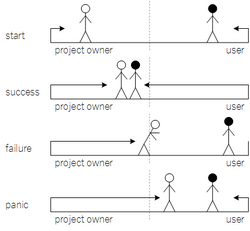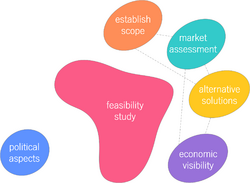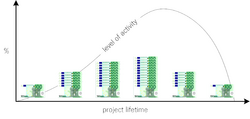Feasibility Study
A Feasibility Study (FS) serves as a holistic decision basis for determining the practicality of a project idea. “There is nothing more unproductive than to build something efficiently that should not have been built at all.” Tim Bryce, Managing Director of M. Bryce & Associates. Worthwhileness is the essential focus of a FS, meaning it aims to determine whether a project is possible and/or reasonable. The distributions of recourses during the lifetime of a project are naturally negatively skewed, consequently it is most beneficial to address adjustments, optimizations, risks, limitations etc. related to a project at the very start. Hence a FS is an optional first stage of a project, where all major aspects of pursuing a given project are studied on a high level.
Conducting a FS enables an objective analysis of a project idea on several measurable aspects. The exact steps of a FS may vary depending a given project type. Typically it will include scope specifications defining the objectives of the project, analysation of the current market stating availible solutions and the potential value of completing the project, an investigation of alternative solutions which satisfy the project objectives and a financial study covering among others the total cost and benefit estimation.
Since a FS requires a considirable investment at an early stage of a project it will mainly be sensible for large projects, where early changes potentially lead to profit in the long run. Moreover the project need to be of a certain open characteristic and/or hold unknown factors in order to potentially benefit from a FS.
Contents |
Conducting a Feasibility Study
There are several sub-studies included in a FS, here five of the most versatile are addressed, i.e. scoping, current market analysis, addressing alternatives solutions, financial study and clarification of political agendas. Bear in mind that a FS is time dependent and thus will only be applicable for a certain project at a specific time. Completing a FS shapes the potential initiation of a project, therefor it is of great importance that it provides a well-informed basis for deciding the direction of this first step in to the realisation of the project. The reliability and strength of a FS depends on the quality of each sub-study as well as on the dynamic managing of the interdependencies between the studies, such as revision of the scope due to a discovery encountered during market studying. Visually presented on the figure to the right, so to say that the stability of the step depends on how well the centre of the paw is supported by the toes. To illustrate the essence of each of the five sub-studies an example of a rail- and highway water crossing is used in the following.
Establish scope
To ensure the quality of a FS specifications of objectives need to be established. This includes the background and the purpose of the project, requirements which need to be met once the project is finalised, the budget and the time frame. Scoping at this stage may be of open as well as well-defined characteristics depending on the requirements needed to be satisfied. All other steps of the FS will be based on the scope, therefore an inadequate scope will lead to misleading results and a too narrow scope may result in sufficient alternative solutions being overlooked. In some cases, it may be recommended to carry out initial studies in order to roughly estimate if the objectives of the scope are sensible. This mainly concerns projects where data from similar cases are not available or simply do not exist.
In our rail- and highway water crossing example a scope should specify who will benefit from it, what the problem is with the current solution, it could be a ferry line or a crossing at a different geological location. The location should also be stated as this will be governing for the length and the foundation of the structure. Clearly the contents of the project need to be addressed, which are the number of lanes, speed limits, safety requirements etc. Lastly a rough estimation of effects should be included, such as the reduction of travelling time, how many travellers and the like.
Market assessment

Analysing the current solutions to the problem may cover investigating copyrights, regulations and faults in current system if there already is one. This step will uncover whether the concerned project is in fact a suitable solution and if there is a sufficient demand. If so this investigation will contribute with an overview of the users' needs and thereby the scope of the project may change accordingly. Figure 2 demonstrates the importance of this part of the FS, similarly as was seen in Video 1, the success of a project largely depends on the ability of attracting users by creating or meeting their needs. On the other hand, the conclusion may be that repairing the existing solution will be a more viable choice than pursuing the project. If the latter is the case one must be careful to keep focus on the task and make sure not use unnecessary time on optimizing the existing solution. Furthermore, the sub-study assesses whether the needed resources are available on the market at the time of executing the project.
Regarding the water crossing project a study of the current market should include an investigation of the type and number of user who potentially will prefer the new solution over the existing. Additionally, it should present a technical prognosis of how the new water crossing will affect the traffic in the future, which will form the basis of the financial study and determine the needed capacity. Moreover, the existing solutions must be examined and their shortcomings specified. Once this part of the study is performed it will provide a clear picture of the magnitude of the demand, thus how much support the project is expected to receive or conclude that expanding the existing road or setting in an extra ferry is a more practical solution. If the former is the case the recourses on the market will be examined based on the alternative solution, consequently it may determine which of the proposed solutions is attainable at the time in concern.
Alternative solutions
Based on the specifications manifested in the scope, which may have been revised once the market analysis is completed, alternative solutions can be proposed and considered. Initially this step requires a brainstorm exercise to create a palette of sufficient solutions to the problem in concern. The space for innovation is marked by the scope, hence if allowed a creative atmosphere with participants of different backgrounds may result in surprising solutions. Hereafter the practicality of each solution is investigated, i.e. determining if a given solution is possible to implement within the budget and time frame set for the project. During this evaluation, softer values may also play a role, theses may be obtained from the market assessment, where the preferences of the users are examined.
Alternative solutions to the water crossing will traditionally be various type of bridges and tunnels. As this industry tirelessly continues to pursue even greater challenges, a submerged bridge or a floating tunnel may be the solution to overcome the requirements set out in the scope.[2]. Users will surely have their preferences as some of us humans fear enclosures and some fear heights, which requires a careful handling and an attempt of serving the chosen solution to users.
Economic visibility
Funding of the project will be the first and foremost element of the financial study. In order to engage potential investors an estimate of the economy of the project must be made, including the entire cost estimate, payback time and the potential benefit. A cost estimate will naturally be based on the solution in consideration, where the current market analysis will reveal the cost and availability of different elements required to execute the project. Payback time depends on the costumer group as well as the number of customers which are approached.
The water crossing may be of interest for several types of investors, be it on state, municipality or private level. Once these are identified negotiations of whether there should be a costumer payment can take place. If so, a complex mapping of users will be provided by the market assessment and used as basis for determining a reasonable user fee and even a differentiation of regular and occasional users, to estimate the income once the crossing is in the function.
Political aspects
Political aspects will often have an effect on all of the other sub-studies, such as restrictions on allowable work environments, use of approved materials, minimum wage etc. The more direct political aspects are more powerful if percent. Figure 2 shows it as the thumb of the paw, reason being that once it becomes part of the step it will have significant influence of the direction and may even pull the break on given project. On a state level, it may be required to clarify who owns the project idea and what the agenda behind it is. Moreover, stating its position in the current or future political direction may be compulsory. On an organizational level, this sub-study may include examination of the organizational policies and argumentation for how the project is in compliance with these. Strategy is closely related to these terms and should be considered as a crucial part of the FS if the project is pursued by a government, organization or company wishing to continue developing and creating success in the future.
Rail- and highways must usually fulfil the governmental restrictions and for a water crossing is mostly constrained to take in to account the local area on both sides, which may in different municipalities [3] or even in different countries[4].
Limitations
In order for a FS to add considerable value it requires a certain flexibility of the scope to implement discoveries made in the FS. Thus, if a project is part of a larger program and therefore cannot be changed due to the fact that it is designed to fit the puzzle, a FS may be unnecessary. Programs and projects often have a built-in point of no return which typically will be at the time of initiation, that is the time when the large sums start rolling out and the income will only be realised if the program or project is completed. For the water crossing example used in the previous section, the FS for constructing the water crossing may have been carried out years before realisation due to temporary setbacks or varying governmental support. This may mean that the railway upgrade on land has been carried out long ahead of the construction of the crossing. As a FS is time dependent it may mean that innovation has played a trick on the prognosis used in the FS, so that the trains may have developed in a way that was not foreseen. Such a situation will often require a complete new FS to determine whether the original plan should be aborted due to the benefits of implementing the new rails.
Conducting a FS before pursuing an idea will inevitably take more time than to start right away. As was seen in in video 1 skipping this stage can have great consequences. That said, the opposite can also occur, in some cases the enthusiasm may suffocate from the process or the opportunity may simply pass. Say our water crossing just opened and all are free to drive across for one day and you get the brilliant idea of selling fresh coffee on one land side where you expect there will be a que. Calculating how much you have to sell to avoid a loss, analysing the likelihood of traffic congestion and working out where it is best to stand may firstly take so much time that the opportunity will pass and moreover overwhelm your spontaneity and cause you desire of pursuing the idea to fade. Conclusion being that if there is willingness and recourses to overcome a complete failure one can argue that a FS will not always be advantageous.
Early in a project, investors may not yet have been engaged and therefore the economy can be limited. Deciding whether to conduct a FS or construct a demo of your project idea to attract investors may be a tough choice. One great obstacle of the tool is that it currently is very static, hence it becomes limited to a specific time and place. As projects and programs unavoidably develop in a dynamic manner there is room for improving the methods of conducting FS to accommodate running changes.
Finally, the great limitation that must not be forgotten is the fact that a FS is constructed based on forecasts of the future, which are based on analysations of the past to predict the future. This must never be mistaken for being the true future, hence a FS is bound to be misleading to some extent.
[5].
References
- ↑ Dingle, J. (1985). Project feasibility and manageability. International Journal of Project Management, 3(3), 94-103.
- ↑ Wynne A. (2016). Floating Solutions | Norway's extraordinary bridges plan. Retrieved from https://www.newcivilengineer.com/world-view/floating-solutions-norways-extraordinary-bridges-plan/10005414.article
- ↑ Eystur- og Sandoyartunlar (2016). The Eysturoy tunnel. Retrieved from http://www.estunlar.fo/en/about-the-tunnels/the-eysturoy-tunnel/
- ↑ Femern A/S (2017). Cross-border co-operation. Retrieved from http://femern.com/en/Benefits/Cross-border-cooperation
- ↑ Hofstrand, D. and Holz-Clause, M. (2009). What is a Feasibility Study? Retrieved from https://www.extension.iastate.edu/agdm/wholefarm/pdf/c5-65.pdf
Annotated Bibliography
Keep in mind
Structure
- Big idea: describe the tool, concept or theory and explain its purpose. The section should reflect the current state of the art on the topic
- Application: provide guidance on how to use the tool, concept or theory and when it is applicable
- Limitations: critically reflect on the tool/concept/theory. When possible, substantiate your claims with literature
- Annotated bibliography: Provide key references (3-10), where a reader can find additional information on the subject. Summarize and outline the relevance of each reference to the topic. (around 100 words per reference). The bibliography is not counted in the suggested 3000 word target length of the article.
Evaluation
- Quality of the summary: Does the summary make the key focus, insights and/or contribution of the article clear?
- Structure and logic of the article: Is the argument clear? Is there a logical flow to the article? Does one part build upon the other? Is the article consistent in its argument and free of contradictions?
- Grammar and style: Is the writing free of grammatical and spelling errors? Is the language precise without unnecessary fill words?
- Figures and tables: Are figures and tables clear? Do they summarize the key points of the article in a meaningful way?
- Interest and relevance: Is the article of high practical and / or academic relevance? Is it made clear in the article why / how it is relevant?
- Depth of treatment: Is the article interesting for a practitioner or academic to read? Does it make a significant contribution beyond a cursory web search?
- Annotated bibliography: Does the article properly cite and acknowledge previous work? Does it briefly summarize the key references at the end of the article? Is it based on empirical data instead of opinion?

